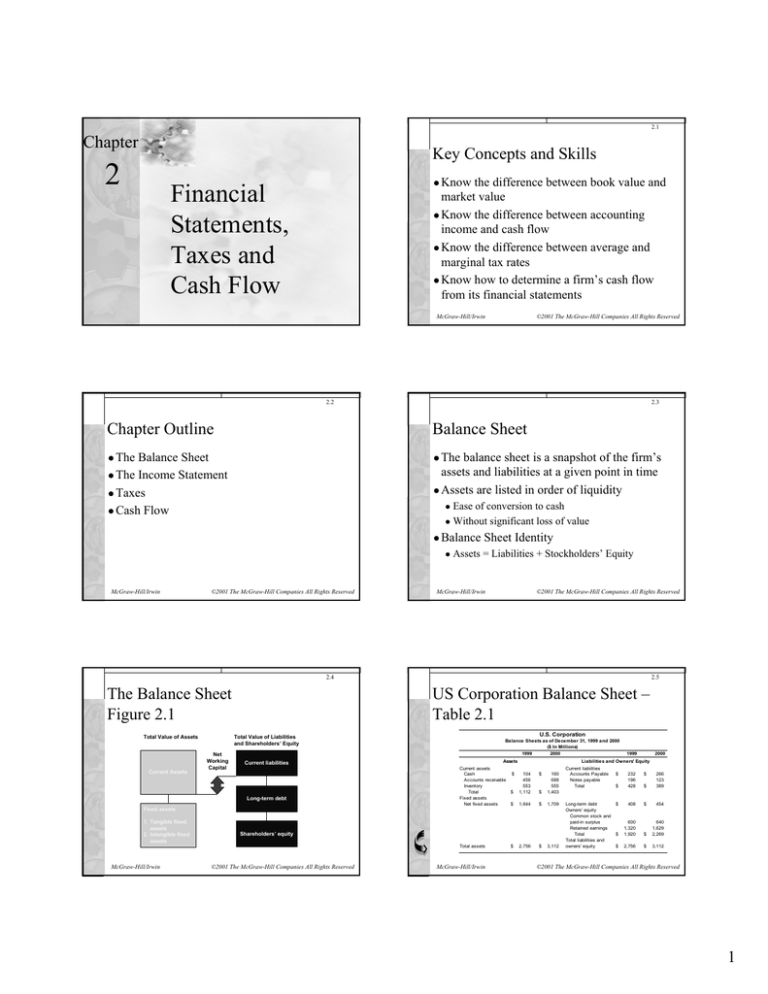
2.0
Chapter
2.1
Key Concepts and Skills
2
z Know
the difference between book value and
market value
z Know the difference between accounting
income and cash flow
z Know the difference between average and
marginal tax rates
z Know how to determine a firm’s cash flow
from its financial statements
Financial
Statements,
Taxes and
Cash Flow
McGraw-Hill/Irwin
©2001 The McGraw-Hill Companies All Rights Reserved
McGraw-Hill/Irwin
©2001 The McGraw-Hill Companies All Rights Reserved
2.2
2.3
Chapter Outline
Balance Sheet
z The
z The
Balance Sheet
z The Income Statement
z Taxes
z Cash Flow
balance sheet is a snapshot of the firm’s
assets and liabilities at a given point in time
z Assets are listed in order of liquidity
z
z
Ease of conversion to cash
Without significant loss of value
z Balance
z
McGraw-Hill/Irwin
©2001 The McGraw-Hill Companies All Rights Reserved
Sheet Identity
Assets = Liabilities + Stockholders’ Equity
McGraw-Hill/Irwin
©2001 The McGraw-Hill Companies All Rights Reserved
2.4
The Balance Sheet
Figure 2.1
Total Value of Assets
Current Assets
US Corporation Balance Sheet –
Table 2.1
Net
Working
Capital
Current liabilities
Long-term debt
McGraw-Hill/Irwin
U.S. Corporation
Total Value of Liabilities
and Shareholders’ Equity
Fixed assets
1. Tangible fixed
assets
2. Intangible fixed
assets
2.5
Balance Sheets as of December 31, 1999 and 2000
($ In Millions)
1999
2000
Assets
Current assets
Cash
Accounts receivable
Inventory
Total
Fixed assets
Net fixed assets
$
$
$
104
456
553
1,112
$
160
688
555
1,403
$
1,644
$
1,709
Shareholders’ equity
Total assets
©2001 The McGraw-Hill Companies All Rights Reserved
McGraw-Hill/Irwin
$
1999
2000
Liabilities and Owners' Equity
2,756
$
3,112
Current liabilities
Accounts Payable
Notes payable
Total
Long-term debt
Owners' equity
Common stock and
paid-in surplus
Retained earnings
Total
Total liabilities and
owners' equity
$
232
196
428
$
$
$
266
123
389
$
408
$
454
$
600
1,320
1,920
$
640
1,629
2,269
$
2,756
$
3,112
©2001 The McGraw-Hill Companies All Rights Reserved
1
2.6
Market Vs. Book Value
2.7
Example 2.2 Klingon Corporation
z The
balance sheet provides the book value of
the assets, liabilities and equity.
z Market value is the price at which the assets,
liabilities or equity can actually be bought or
sold.
z Market value and book value are often very
different. Why?
z Which is more important to the decisionmaking process?
McGraw-Hill/Irwin
©2001 The McGraw-Hill Companies All Rights Reserved
NWC
NFA
KLINGON CORPORATION
Balance Sheets
Market Value versus Book Value
Book Market
Book Market
Assets
Liabilities and
Shareholders’ Equity
$ 400 $ 600 LTD
$ 500 $ 500
700 1,000 SE
600 1,100
1,100 1,600
1,100 1,600
McGraw-Hill/Irwin
©2001 The McGraw-Hill Companies All Rights Reserved
2.8
2.9
US Corporation Income Statement –
Table 2.2
Income Statement
z The
income statement is more like a video of
the firm’s operations for a specified period of
time.
z You generally report revenues first and then
deduct any expenses for the period
z Matching principle – GAAP say to show
revenue when it accrues and match the
expenses required to generate the revenue
McGraw-Hill/Irwin
©2001 The McGraw-Hill Companies All Rights Reserved
U.S. CORPORATION
1998 Income Statement
($ In Millions)
Net sales
$ 1,509
Cost of goods sold
750
Depreciation
65
Earnings before interest and taxes
$
694
$
624
$
412
Interest paid
70
Taxable income
Taxes
212
Net income
Dividends
$
Addition to retained earnings
McGraw-Hill/Irwin
103
309
©2001 The McGraw-Hill Companies All Rights Reserved
2.10
2.11
Taxes
Example: Marginal Vs. Average
Rates
z The
z Suppose
one thing we can rely on with taxes is that
they are always changing
z Marginal vs. average tax rates
Marginal – the percentage paid on the next dollar
earned
z Average – the tax bill / taxable income
z
z Other
taxes
McGraw-Hill/Irwin
©2001 The McGraw-Hill Companies All Rights Reserved
income.
your firm earns $4 million in taxable
What is the firm’s tax liability?
What is the average tax rate?
z What is the marginal tax rate?
z
z
z If
you are considering a project that will
increase the firm’s taxable income by $1
million, what tax rate should you use in your
analysis?
McGraw-Hill/Irwin
©2001 The McGraw-Hill Companies All Rights Reserved
2
2.12
2.13
The Concept of Cash Flow
Cash Flow From Assets
z Cash
z Cash
flow is one of the most important pieces
of information that a financial manager can
derive from financial statements
z The statement of cash flows does not provide
us with the same information that we are
looking at here
z We will look at how cash is generated from
utilizing assets and how it is paid to those that
finance the purchase of the assets
McGraw-Hill/Irwin
©2001 The McGraw-Hill Companies All Rights Reserved
Flow From Assets (CFFA) = Cash Flow
to Creditors + Cash Flow to Stockholders
z Cash Flow From Assets = Operating Cash
Flow – Net Capital Spending – Changes in
NWC
McGraw-Hill/Irwin
2.14
Cash Flow Summary
Table 2.5
I. The cash flow identity
Cash flow from assets = Cash flow to creditors (bondholders)
+ Cash flow to stockholders (owners)
II. Cash flow from assets
Cash flow from assets = Operating cash flow
- Net capital spending
- Change in net working capital (NWC)
where
Operating cash flow = Earnings before interest and taxes (EBIT)
+ Depreciation - Taxes
Net capital spending = Ending net fixed assets - Beginning net fixed assets
+ Depreciation
Change in NWC = Ending NWC - Beginning NWC
III. Cash flow to creditors (bondholders)
Cash flow to creditors = Interest paid - Net new borrowing
IV. Cash flow to stockholders (owners)
Cash flow to stockholders = Dividends paid - Net new equity raised
McGraw-Hill/Irwin
©2001 The McGraw-Hill Companies All Rights Reserved
©2001 The McGraw-Hill Companies All Rights Reserved
2.15
Quick Quiz
What is the difference between book value and
market value? Which should we use for decision
making purposes?
z What is the difference between accounting income
and cash flow? Which do we need to use when
making decisions?
z What is the difference between average and
marginal tax rates? Which should we use when
making financial decisions?
z How do we determine a firm’s cash flows? What
are the equations and where do we find the
information?
z
McGraw-Hill/Irwin
©2001 The McGraw-Hill Companies All Rights Reserved
3





